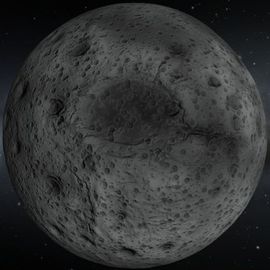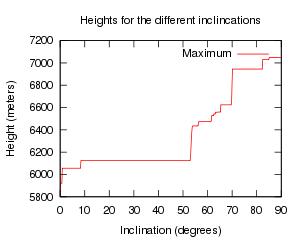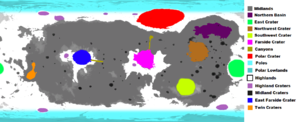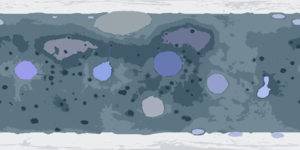Difference between revisions of "Mun/ja"
Kspjptrans (talk | contribs) (→ゲーム内の説明) |
Kamonanban (talk | contribs) m (Update) |
||
| (34 intermediate revisions by 4 users not shown) | |||
| Line 1: | Line 1: | ||
| − | {{ | + | {{Infobox/Body}} |
| − | ''' | + | '''ムン'''(Mun)は、時には'''Mün'''とも表記される、[[Kerbin/ja|カービン]]を周回する比較的大きな[[:Category:Moons|衛星]]である。現実における地球の月の類似物で、しばしば“[[w:ja:%E6%9C%88#.E6.A6.82.E8.A6.81|月]]”(ラテン語で''Luna'')とそのまま呼ばれる。 |
| − | 地表は灰色で、大小様々な[[w: | + | 地表は灰色で、大小様々な[[w:ja:クレーター|クレーター]]と、標高5029mを超える[[w:ja:山|山]]々が存在する。表面重力は1.63 m/s²でカービンと比較するとおよそ1/6で8.18 m/s²の差がある。ちなみに現実の地球の月の表面重力は1.624 m/s²である。[[Tutorial:Mun Landing|ムンに着陸]]できるのはもちろん、[[Tutorial: Gravity Assist|重力アシスト]](スイングバイ)に利用して、[[Minmus/ja|ミンマス]]や、[[Kerbol/ja|太陽(カーボル)]]軌道に向かうために、カービン脱出軌道に乗ることもできる。 ムンでのスイングバイは方向を精密に制御できず、燃料をそこまで節約できる訳でもないが、タイミングを調整すれば増速や減速に有効だ。 |
| − | + | 新規プレイヤーはムン(ほか大多数の天体)には[[atmosphere/ja|大気]]が存在しないことに注意すべきだ。これは[[parachute/ja|パラシュート]]が地表への着陸手段として使えないことを意味している。 | |
| − | + | ムンの表面ではアノマリ(イレギュラーな構造体)がいくつか存在している。 | |
| − | + | ムンの同期軌道は高度{{OrbitAltitude | period=138984.376574476 | mass=9.76002360215472e20 | radius=200000 |factor=k}}にあるが、すでに重力圏外なため維持することは不可能である。しかしムンの重力圏のほんの少し外側で、ムンとおなじ軌道長半径のカービン周回軌道に乗ることで、擬似的にムン静止軌道を取ることができる。カービン低軌道からムン作用圏を捉え近点高度25 kmに到達するには約860 m/sのdelta Vが必要であり、ムン遠点高度も25 kmにして周回軌道に乗るには約260 m/sのdelta Vが必要である。なお準同期軌道は高度約1797.41kmである。 | |
| − | + | ||
| + | [[tutorials/ja|チュートリアル]]にて[[Tutorial:Mun Landing|ムンへの旅行]]を解説している。 | ||
== ゲーム内の説明 == | == ゲーム内の説明 == | ||
| Line 16: | Line 17: | ||
{{Quote | {{Quote | ||
| − | | | + | |ムンはカービンの軌道を周回する大きな衛星です。ほぼ灰色の天体で、地表のほとんどが大小さまざまなクレーターで覆われています。<br>ムンの発見は、カーバルの進化において最も大きな飛躍の1つであると考えられています。発見されたのはそれほど遠い昔のことではありませんが、当時よりもカーバルたちは知恵をつけて確実に進化していると言えるでしょう。 |
| − | <br> | ||
| − | | | + | |カーバル天文学会}} |
| − | == | + | == 地勢 == |
[[File:Mun heights.svg|thumb|left|The minimum height for the different inclinations]] | [[File:Mun heights.svg|thumb|left|The minimum height for the different inclinations]] | ||
| − | + | ムンの地形は荒く、灰色で、クレーターがはっきり残っているのが特徴だ。低地は表土がより濃い灰色になる傾向がある。ムンにも峡谷が存在しておりその深さは数百m、全長は数kmに及ぶ。 | |
| − | + | ムン地形の最高高度地点は南極近くの西経152.33°南緯82.52°にあり、7061 m以上の高度がある。この高度では10倍速[[Time warp|ワープ]]が可能だが、 allowing crashes with terrain while being in a seemingly stable orbit.最低高度地点は北の大クレーター南西よりの西経76.63°北緯35.32°で高度は-247 mである。 | |
| − | + | 地表の細部要素はグラフィック設定により岩や小石が出現する。他惑星の細部要素と同様にムンの岩なども当たり判定のない装飾で宇宙船や[[Kerbal/ja|カーバル]]が衝突することはない。 | |
| − | + | 0.21でプロシージャル生成されたクレーターが散りばめられ、着陸が難しくなった。それまでの高度0mの最低地点は東側の大きなクレーター(35.42° E, 8.27° N)だった。 | |
| − | + | 機体をリロードするとオブジェクトがカービン重力圏外まで放り出されてしまう「地獄の[[Kraken|クラーケン]]」現象が、ムンで以前見られた。 | |
| − | + | ムンにもいくつかの隠し要素があり探索することで発見できる: | |
{{SpoilerBox | {{SpoilerBox | ||
| − | |description= | + | |description=[[Easter egg/ja|イースターエッグ]] |
|content= | |content= | ||
| − | * | + | * 大きな石のアーチが3つある。その大きさから赤道付近を高度10000m以下で周回していれば容易に発見できる。 |
| − | * | + | * 人類最初の月面着陸者Neil Armstrongの記念碑が建っている。一番大きなクレーターの南の壁付近にある。 この場所はアポロ11号が月に着陸した地点とほぼ一致している。低軌道から白い点として微かに視認できる。 |
| − | * | + | * モノリス(捩ってMunolithとも)が3つある。モノリスは小さく、発見するのは非常に難しい。ひとつは地中に、残り2つはそれぞれ非常に深い縦穴の中にある。 |
| − | |||
}} | }} | ||
| − | == | + | == バイオーム == |
| − | [[File:MunBiomeMap.png|left|thumb| | + | [[File:MunBiomeMap.png|left|thumb|ムンのバイオーム分布図]] |
| − | + | 0.90以前は、ムンは複数のバイオームが存在する数少ない天体の1つであり、合計17の最も多く[[biome/ja|バイオーム]]を有する天体であった。主要な大型クレーターはそれぞれ独自のバイオームとなっており、固有名称が与えられている。内陸や高地に存在する中型クレーターには固有名称は無いが、各バイオームのクレーターとして別に扱われている。極地には3つの異なるバイオームが存在している。7つの異なるクレーターと2つの盆地が存在する。{{clear|left}} | |
| − | + | ||
| − | * | + | === バイオーム一覧 === |
| − | * | + | {{Biome list| |
| − | * | + | * 極地 |
| − | * | + | * 極地の低地 |
| − | * | + | * 極地のクレーター |
| − | * | + | * 高原 |
| − | * | + | * 高原のクレーター |
| − | * | + | * 内陸 |
| − | * | + | * 内陸のクレーター |
| − | * | + | * 低地 |
| − | * | + | * 南の盆地 |
| − | * | + | * 裏側の盆地 |
| − | * | + | * 北西のクレーター |
| − | * | + | * 裏側東のクレーター |
| − | * | + | * 大峡谷 |
| + | * 裏側のクレーター | ||
| + | * 東のクレーター | ||
| + | * ツイン・クレーター | ||
| + | * 南西のクレーター}} | ||
| + | |||
| + | == カービンからの観測 == | ||
| + | |||
| + | ムンの軌道はカービンの赤道面と一致している。ムンが潮汐固定(自転周期と公転周期が一致)されていること、軌道が完全な円であること、軌道傾斜が無いことから、カービンから観測できるムン地表は常に同一のちょうど50%(山陰など地形に起因するものは無視する)のみである。 | ||
| − | + | 軌道傾斜が無いためムンがカービンと太陽の間を通過するたびに[[Light|日食]]が発生する。グラフィックエンジンの制約から現在、日食による暗転や影の発生はしない。しかし日光の遮断は処理されており[[solar panel|太陽光発電機]]はムンの影に入る短時間機能しなくなる。 | |
| − | + | A full Kerbolar eclipse can be observed while landed at KSC starting after game time Year 1, Day 351 - 5h, 40m, and ending (being partial again) somewhere around Year 1, Day 352 - 0h, 22m. Not sure of other occurences or locations, but this one at KSC is confirmed (unless game times and positions of bodies varies between players). Apparently a Kerbolar eclipse happens every 6 days, according to a random online source (too lazy to do math or test). | |
| − | + | Although the game graphics depict Mun as totally covering the solar disk during an eclipse, based on the given diameters of Sun and Mun and their distances from Kerbin, Sun has a larger apparent size. For observers on and near Kerbin, solar eclipses would be annular. | |
| − | == | + | == カービンの観察 == |
| − | + | 潮汐固定のため、ムン地表のうちカービンに面した50%でのみ観察することが出来、残り50%ではその姿を見ることは絶対に出来ない。カービンを[[w:ja:天頂|天頂]]で観察できるのはムンの東経でおよそ47°の地点である。ムンの赤道はカービンの赤道と同一平面上にあるため、ムンの赤道上にいる限りカービンの赤道面にいることになる。カービンはムンから潮汐固定を受けているわけではないため、ムンのうち観察できる50%側であればカービン全ての地表を観察することが可能で、裏側であってもカービンの自転にあわせて観察できるようになる。カービンとムンの[[w:ja:朔望月|朔望周期]]は25617.909秒で、Kerbol太陽日(1日約6時間)では1.18323日である。 | |
| − | == | + | == サイエンス == |
| − | + | ムンにおける[[science|サイエンス]]ポイント乗数は他の天体に比べ、地表上空いずれもかなり低い設定になっている。しかしムン到達は比較的容易であり、多数のバイオームはそれぞれ別の実験結果を得ることができる。そのためゲーム中盤では[[Minmus/ja|ミンマス]]と並び重要なポイント獲得源となる。 | |
| − | == | + | == 時間加速 == |
{{:Mun/RefFrame}} | {{:Mun/RefFrame}} | ||
| − | == | + | == ギャラリー == |
<gallery> | <gallery> | ||
| − | File:Mun_color.png| | + | File:Mun_color.png|version 0.14.2 ~ 0.20.2の間のムン地勢図。 |
| − | File:Isa_mapsat_mun_map800.gif| | + | File:Isa_mapsat_mun_map800.gif|ISA MapSatプラグインで作成した地勢図。 |
| − | File:Large lander on Mun.png | | + | File:Large lander on Mun.png |着陸に成功した二人乗り宇宙船。新規プレイヤーには着陸船設計の指標になる。 |
| − | File:0.21 Kerbal Staring Sun From Moon --Copyright by Squad--.jpg| | + | File:0.21 Kerbal Staring Sun From Moon --Copyright by Squad--.jpg|ムンで日の出を見るカーバル。カーバルって目閉じられないけど大丈夫かな? |
| − | File: | + | File:MoonRoverNight.png |ムン地表のクレーターを夜に走行するローバー。 |
| − | File: | + | File:Solar Eclipse.jpg |ムンによる日食。日光が遮られて燃料計の通り発電できていない。 |
| − | File: | + | [[File:MunCrashLanding.png|thumbnail|A Kerbal standing next to his crashed Mun lander.]] |
| − | File: | + | File:Arrived_at_mun.png| A vessel has just entered Munar orbit and is getting ready to initiate a landing. |
| − | File: | + | File:Screenshot37.png|A proud little probe recharges its [[battery|batteries]] after landing on the Mun, prior to sending back precious [[science]] data. |
| + | File:Screenshot85.png|A victorious landing party celebrates a safe trip with a Munar selfie. | ||
| + | File:Screenshot87.png|A lander returns to orbit to dock with its mothership and offload crew and data. | ||
</gallery> | </gallery> | ||
{{SpoilerBox | {{SpoilerBox | ||
| − | |description= | + | |description=ネタバレ注意 イースターエッグの写真 |
|content= | |content= | ||
<gallery> | <gallery> | ||
| − | File:Mun_arch.jpg| | + | File:Mun_arch.jpg|ムンのアーチ |
| − | File:Munar_Arch.png| | + | File:Munar_Arch.png|version 0.20.2で発見された別のアーチ |
| − | File:Arch_on_Mun.png| | + | File:Arch_on_Mun.png|カービンに面した大型クレーター北側の淵にあるアーチ |
| − | File:Monolith.jpg| | + | File:Monolith.jpg|モノリス |
| − | File:Armstrong.png| | + | File:Armstrong.png|ニール・アームストロングの記念碑 |
| + | File:Crashed UFO.png|大破したUFO</gallery> | ||
}} | }} | ||
| − | == | + | == トリビア == |
| − | [[File:StartGameMenu.0.21.1.png|thumb|''Mün or Bust'' | + | [[File:StartGameMenu.0.21.1.png|thumb|ゲームメニューの'''Mün or Bust!''']] |
| − | * | + | * 実装後、当初多くのプレイヤーは'''Mün'''(uに[[w:ja:トレマ|トレマ]])をスペルミスだと思い"moon"と同じ発音をしていた。しかし一部の開発者が'''ムン'''と言っているのが確認され"muhn"と発音されるようになった。タイトルメニューの"Mün地表"で墜落している[[Kerbal X]]に似た着陸船の側面には"Mün or Bust!"と殴り書きされている。'''Mün'''・'''Mun'''どちらの表記もプレイヤーに広く一般に受け入れられているが、ゲーム内での表記は'''Mun'''である。 |
| − | + | * ムンはカービンにとってもゲームにとっての「第1」の月だった。 | |
| − | * | + | * ムンの軌道は完全な円形で軌道傾斜も無いが、これは惑星系形成の過程でチリや小天体だけでなく中心星や他の惑星も存在しないことが必要であり、現実にはこのような機能になる可能性は非常に低い。 |
| − | ** This | + | ** これは新規プレイヤーでも容易に到達で来るようにするための措置だろう。 |
| − | * | + | ** This also makes it an excellent guideline to use for placing satellites into exact inclinations around Kerbin. By setting Mun as target, the relative inclination described by the maneuver tool also represents the inclination of the satellite's orbit to Kerbin |
| − | * | + | * {{version|0.14.2}}以前では、ムン地表の高い地点でも高度は600m程度までしかなかった。 |
| − | * | + | * プロシージャル生成の地表になる前は、標高の高い地点は赤道から南北45度までの範囲に集中し、北半球の大きなクレーターの東側の縁(129.64° W, 0.97° N)の2967mが最高地点だった。 |
| + | * {{version|0.14.3}}以前ではムンにも宇宙センターがあった。 | ||
| + | * The Mun is considerably larger than 1/10 the size of the real world Moon. | ||
| + | * The Mun is one of the few bodies in the solar system that is almost completely manually colored (i.e., it uses a color map). Most other planets and moons are colored procedurally or with a lot of procedural colors doing the work. The only procedural colors on the Mun are associated with the procedural craters and a basic noise. The other planets which are manually colored are Tylo (Aside from a tenuous coat of height color map) and Jool (As a gas giant, it must be manually colored) | ||
| − | == | + | == 変更点 == |
| − | ; | + | ;[[1.3]] |
| − | * | + | * Changed displayName to The Mun, removed useTheInName feature. |
| − | ; | + | ;[[1.2]] |
| − | * | + | * バイオームを追加。 |
| − | ; | + | ;[[0.21]] |
| − | * | + | * プロシージャル生成のテクスチャが追加され、クレーターが詳細になった。 |
| − | ; | + | ;[[0.20.1]] |
| − | * [[List of easter eggs| | + | * 高度を元の値に戻す。 |
| − | * | + | ;[[0.20]] |
| − | ; | + | * 地形オーバーホール。 |
| − | * | + | ;[[0.18]] |
| − | ; | + | * [[List of easter eggs|イースターエッグ]]追加 (追加1、修正1)。 |
| − | * | + | * 外観変更。 |
| − | ; | + | ;[[0.17]] |
| − | * | + | * テクスチャ改善。 |
| − | ; | + | ;[[0.16]] |
| − | * | + | * イースターエッグ追加。 |
| − | ; | + | ;[[0.15]] |
| − | * | + | * テクスチャ改善。 |
| − | ; | + | ;[[0.14.3]] |
| − | * | + | * ムンにあった宇宙センターを削除(お察しください)。 |
| + | ;[[0.14.2]] | ||
| + | * 地形オーバーホール。 | ||
| + | ;[[0.12]] | ||
| + | * 実装。 | ||
| − | == | + | == 注釈 == |
<references /> | <references /> | ||
{{Celestial Bodies}} | {{Celestial Bodies}} | ||
| − | [[Category:Celestials]] | + | [[Category:Celestials/ja]] |
| − | [[Category:Moons]] | + | [[Category:Moons/ja]] |
Latest revision as of 11:16, 6 November 2018
| ムン
(Mun) | ||
| 軌道からみたムン | ||
| 衛星 周回 カービン | ||
| 軌道の特徴 | ||
| 軌道長半径 | 12 000 000 m [Note 1] | |
| 軌道遠点 | 12 000 000 m [Note 1] | |
| 軌道近点 | 12 000 000 m [Note 1] | |
| 軌道離心率 | 0 | |
| 軌道傾斜角 | 0 ° | |
| 近点引数 | 0 ° | |
| 昇交点黄経 | 0 ° | |
| 平均近点角 | 1.7 rad (で 0秒 UT) | |
| 軌道周期 | 138 984 秒 | |
| 6 d 2 h 36 m 24.4 s | ||
| 会合周期 | 141 115.4 秒 | |
| 軌道速度 | 543 m/秒 | |
| 最長の日食 | 2 213 秒 | |
| 体格的特徴 | ||
| 赤道半径 | 200 000 m | |
| 赤道周長 | 1 256 637 m | |
| 表面積 | 5.0265482×1011 m2 | |
| 質量 | 9.7599066×1020 kg | |
| 標準重力パラメータ | 6.5138398×1010 m3/秒2 | |
| 密度 | 29 125.076 kg/m3 | |
| 表面重力 | 1.63 m/秒2 (0.166 g) | |
| 宇宙速度 | 807.08 m/秒 | |
| 恒星回転周期 | 138 984.38 秒 | |
| 6 d 2 h 36 m 24.4 s | ||
| 恒星回転速度 | 9.0416 m/秒 | |
| 同期軌道 | 影響力の範囲外 | |
| 作用圏 | 2 429 559.1 m [Note 1] | |
| 大気の特性 | ||
| 大気の有無 | いいえ | |
| サイエンスポイント倍率 | ||
| 着陸 | 4 | |
| 着水 | N/A | |
| 低高度宇宙 | 3 | |
| 高高度宇宙 | 2 | |
| 回収 | 2 | |
|
| ||
ムン(Mun)は、時にはMünとも表記される、カービンを周回する比較的大きな衛星である。現実における地球の月の類似物で、しばしば“月”(ラテン語でLuna)とそのまま呼ばれる。
地表は灰色で、大小様々なクレーターと、標高5029mを超える山々が存在する。表面重力は1.63 m/s²でカービンと比較するとおよそ1/6で8.18 m/s²の差がある。ちなみに現実の地球の月の表面重力は1.624 m/s²である。ムンに着陸できるのはもちろん、重力アシスト(スイングバイ)に利用して、ミンマスや、太陽(カーボル)軌道に向かうために、カービン脱出軌道に乗ることもできる。 ムンでのスイングバイは方向を精密に制御できず、燃料をそこまで節約できる訳でもないが、タイミングを調整すれば増速や減速に有効だ。
新規プレイヤーはムン(ほか大多数の天体)には大気が存在しないことに注意すべきだ。これはパラシュートが地表への着陸手段として使えないことを意味している。
ムンの表面ではアノマリ(イレギュラーな構造体)がいくつか存在している。
ムンの同期軌道は高度2 970.58 kmにあるが、すでに重力圏外なため維持することは不可能である。しかしムンの重力圏のほんの少し外側で、ムンとおなじ軌道長半径のカービン周回軌道に乗ることで、擬似的にムン静止軌道を取ることができる。カービン低軌道からムン作用圏を捉え近点高度25 kmに到達するには約860 m/sのdelta Vが必要であり、ムン遠点高度も25 kmにして周回軌道に乗るには約260 m/sのdelta Vが必要である。なお準同期軌道は高度約1797.41kmである。
Contents
ゲーム内の説明
| 「 | ムンはカービンの軌道を周回する大きな衛星です。ほぼ灰色の天体で、地表のほとんどが大小さまざまなクレーターで覆われています。 ムンの発見は、カーバルの進化において最も大きな飛躍の1つであると考えられています。発見されたのはそれほど遠い昔のことではありませんが、当時よりもカーバルたちは知恵をつけて確実に進化していると言えるでしょう。 — カーバル天文学会 |
」 |
地勢
ムンの地形は荒く、灰色で、クレーターがはっきり残っているのが特徴だ。低地は表土がより濃い灰色になる傾向がある。ムンにも峡谷が存在しておりその深さは数百m、全長は数kmに及ぶ。
ムン地形の最高高度地点は南極近くの西経152.33°南緯82.52°にあり、7061 m以上の高度がある。この高度では10倍速ワープが可能だが、 allowing crashes with terrain while being in a seemingly stable orbit.最低高度地点は北の大クレーター南西よりの西経76.63°北緯35.32°で高度は-247 mである。
地表の細部要素はグラフィック設定により岩や小石が出現する。他惑星の細部要素と同様にムンの岩なども当たり判定のない装飾で宇宙船やカーバルが衝突することはない。
0.21でプロシージャル生成されたクレーターが散りばめられ、着陸が難しくなった。それまでの高度0mの最低地点は東側の大きなクレーター(35.42° E, 8.27° N)だった。
機体をリロードするとオブジェクトがカービン重力圏外まで放り出されてしまう「地獄のクラーケン」現象が、ムンで以前見られた。
ムンにもいくつかの隠し要素があり探索することで発見できる:
- 大きな石のアーチが3つある。その大きさから赤道付近を高度10000m以下で周回していれば容易に発見できる。
- 人類最初の月面着陸者Neil Armstrongの記念碑が建っている。一番大きなクレーターの南の壁付近にある。 この場所はアポロ11号が月に着陸した地点とほぼ一致している。低軌道から白い点として微かに視認できる。
- モノリス(捩ってMunolithとも)が3つある。モノリスは小さく、発見するのは非常に難しい。ひとつは地中に、残り2つはそれぞれ非常に深い縦穴の中にある。
バイオーム
0.90以前は、ムンは複数のバイオームが存在する数少ない天体の1つであり、合計17の最も多くバイオームを有する天体であった。主要な大型クレーターはそれぞれ独自のバイオームとなっており、固有名称が与えられている。内陸や高地に存在する中型クレーターには固有名称は無いが、各バイオームのクレーターとして別に扱われている。極地には3つの異なるバイオームが存在している。7つの異なるクレーターと2つの盆地が存在する。バイオーム一覧
|
カービンからの観測
ムンの軌道はカービンの赤道面と一致している。ムンが潮汐固定(自転周期と公転周期が一致)されていること、軌道が完全な円であること、軌道傾斜が無いことから、カービンから観測できるムン地表は常に同一のちょうど50%(山陰など地形に起因するものは無視する)のみである。
軌道傾斜が無いためムンがカービンと太陽の間を通過するたびに日食が発生する。グラフィックエンジンの制約から現在、日食による暗転や影の発生はしない。しかし日光の遮断は処理されており太陽光発電機はムンの影に入る短時間機能しなくなる。
A full Kerbolar eclipse can be observed while landed at KSC starting after game time Year 1, Day 351 - 5h, 40m, and ending (being partial again) somewhere around Year 1, Day 352 - 0h, 22m. Not sure of other occurences or locations, but this one at KSC is confirmed (unless game times and positions of bodies varies between players). Apparently a Kerbolar eclipse happens every 6 days, according to a random online source (too lazy to do math or test).
Although the game graphics depict Mun as totally covering the solar disk during an eclipse, based on the given diameters of Sun and Mun and their distances from Kerbin, Sun has a larger apparent size. For observers on and near Kerbin, solar eclipses would be annular.
カービンの観察
潮汐固定のため、ムン地表のうちカービンに面した50%でのみ観察することが出来、残り50%ではその姿を見ることは絶対に出来ない。カービンを天頂で観察できるのはムンの東経でおよそ47°の地点である。ムンの赤道はカービンの赤道と同一平面上にあるため、ムンの赤道上にいる限りカービンの赤道面にいることになる。カービンはムンから潮汐固定を受けているわけではないため、ムンのうち観察できる50%側であればカービン全ての地表を観察することが可能で、裏側であってもカービンの自転にあわせて観察できるようになる。カービンとムンの朔望周期は25617.909秒で、Kerbol太陽日(1日約6時間)では1.18323日である。
サイエンス
ムンにおけるサイエンスポイント乗数は他の天体に比べ、地表上空いずれもかなり低い設定になっている。しかしムン到達は比較的容易であり、多数のバイオームはそれぞれ別の実験結果を得ることができる。そのためゲーム中盤ではミンマスと並び重要なポイント獲得源となる。
時間加速
| 時間加速中 | 最低高度 |
|---|---|
| 1× | どこでも |
| 5× | 5 000 m |
| 10× | 5 000 m |
| 50× | 10 000 m |
| 100× | 25 000 m |
| 1 000× | 50 000 m |
| 10 000× | 100 000 m |
| 100 000× | 200 000 m |
ギャラリー
トリビア
- 実装後、当初多くのプレイヤーはMün(uにトレマ)をスペルミスだと思い"moon"と同じ発音をしていた。しかし一部の開発者がムンと言っているのが確認され"muhn"と発音されるようになった。タイトルメニューの"Mün地表"で墜落しているKerbal Xに似た着陸船の側面には"Mün or Bust!"と殴り書きされている。Mün・Munどちらの表記もプレイヤーに広く一般に受け入れられているが、ゲーム内での表記はMunである。
- ムンはカービンにとってもゲームにとっての「第1」の月だった。
- ムンの軌道は完全な円形で軌道傾斜も無いが、これは惑星系形成の過程でチリや小天体だけでなく中心星や他の惑星も存在しないことが必要であり、現実にはこのような機能になる可能性は非常に低い。
- これは新規プレイヤーでも容易に到達で来るようにするための措置だろう。
- This also makes it an excellent guideline to use for placing satellites into exact inclinations around Kerbin. By setting Mun as target, the relative inclination described by the maneuver tool also represents the inclination of the satellite's orbit to Kerbin
- バージョン 0.14.2以前では、ムン地表の高い地点でも高度は600m程度までしかなかった。
- プロシージャル生成の地表になる前は、標高の高い地点は赤道から南北45度までの範囲に集中し、北半球の大きなクレーターの東側の縁(129.64° W, 0.97° N)の2967mが最高地点だった。
- バージョン 0.14.3以前ではムンにも宇宙センターがあった。
- The Mun is considerably larger than 1/10 the size of the real world Moon.
- The Mun is one of the few bodies in the solar system that is almost completely manually colored (i.e., it uses a color map). Most other planets and moons are colored procedurally or with a lot of procedural colors doing the work. The only procedural colors on the Mun are associated with the procedural craters and a basic noise. The other planets which are manually colored are Tylo (Aside from a tenuous coat of height color map) and Jool (As a gas giant, it must be manually colored)
変更点
- Changed displayName to The Mun, removed useTheInName feature.
- バイオームを追加。
- プロシージャル生成のテクスチャが追加され、クレーターが詳細になった。
- 高度を元の値に戻す。
- 地形オーバーホール。
- イースターエッグ追加 (追加1、修正1)。
- 外観変更。
- テクスチャ改善。
- イースターエッグ追加。
- テクスチャ改善。
- ムンにあった宇宙センターを削除(お察しください)。
- 地形オーバーホール。
- 実装。
注釈




















